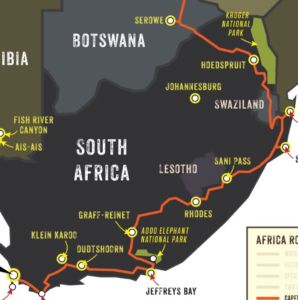Eswatini, formerly known as Swaziland, is a country rich in history, culture and wildlife. However, many know little about it. Traveling here is on Renedian’s Cape Town to Victoria Falls: All Paved Route so here are a few facts to help you get acquainted with it.
 History
History
- Depending on the source, Eswatini (Swaziland) (pop. 1.367 million) has one of the world’s last remaining absolute monarchies or an absolute diarchy. It’s the only country in Africa not practicing multiparty democracy.
- The King, known as Lion, is considered father of the nation and child of the people. The Queen Mother, the King’s mother, is considered the mother of the country and titled ‘She Elephant.” The current king is estimated to have at least thirteen wives.
- Colonized by the British, Swaziland gained independence in 1968. In 2018, King Mswati III officially renamed the country as the Kingdom of eSwatini, meaning “land of the Swazis.”
- The military has never been involved in a foreign conflict. It is used primarily during domestic protests and for border and customs duty.
Geography
- At 17,363 sq km, Eswatini (Swaziland) is the smallest country in Africa, slightly smaller than the state of New Jersey. It extends 176 km north to south and 135 km east to west. Landlocked, it shares its southern, western, and northern borders with South Africa. Mozambique lies to the east.
- Ancient mountains of the western highveld offer dramatic landscapes with lush, fertile valleys, waterfalls, and gorges. Further east, undulating bush and moist savannah characterize the middleveld, the most densely populated region. The hot lowveld is home to impressive sugar estates. The Lubombo, a mountain ridge along the border with Mozambique is cattle ranching country.
Economy
- Eswatini is classified as a lower-middle-income country and is a member of the Southern African Customs Union. Seven in ten people live in abject poverty. About seventy-five percent of the population is employed in subsistence agriculture.
- Agriculture, forestry, and mining account for about thirteen percent of the GDP, manufacturing (textiles and sugar-related processing) about thirty-seven percent, and services (mostly government) fifty percent.
Swaziland rich history and culture
A couple points about Eswatini’s culture
- Most of Eswatini’s population is ethnically Swazi, with a small number of Zulu and White Africans of British and Afrikaner descent.
- Approximately eighty percent of the people practice Christianity, fifteen percent follow traditional religions, and the remainder follow Islam, Bahá’í, Hinduism and Judaism.
- The spectacular Umhlanga Reed Dance, held in late August or early September, is Eswatini’s most well-known cultural event and biggest annual holiday. Up to 40,000 childless, unmarried girls take part in this eight-day ceremony. Dressed in brightly coloured attire, the young girls cut reeds, present them to the Queen Mother (to repair the windbreak around her royal residence), and then dance in celebration.
- Incwala is the country’s most important cultural event and often translated as “first fruits ceremony.” Originating hundreds of years ago, it’s one of the last remaining examples of what was previously common practice in many African countries. Above all, much of it remains shrouded in secrecy. Essentially, Incwala is spiritual ceremony about cleansing, renewal, and celebrating kingship. The event takes place on the fourth day after the full moon nearest the longest day, 21 December—around late December or early January
Education
- Pre-school education begins with infants. Primary education starts at age six and leads to a five-year secondary school program. Finally, those who are able can choose from a mix of universities, technical and vocational colleges, teacher and nursing colleges and business colleges. Adult literacy rate in 2015 was greater than eighty-seven percent.
Wildlife
- For a small country, it hosts an incredible variety of flora and fauna. For instance, there are 507 known bird species, 107 endemic mammal species, and over 3,500 indigenous plant species. Seventeen protected areas give refuge to a diverse range of wildlife, including the “Big Five” (lion, leopard, rhinoceros (white and black), elephant, and Cape buffalo).

